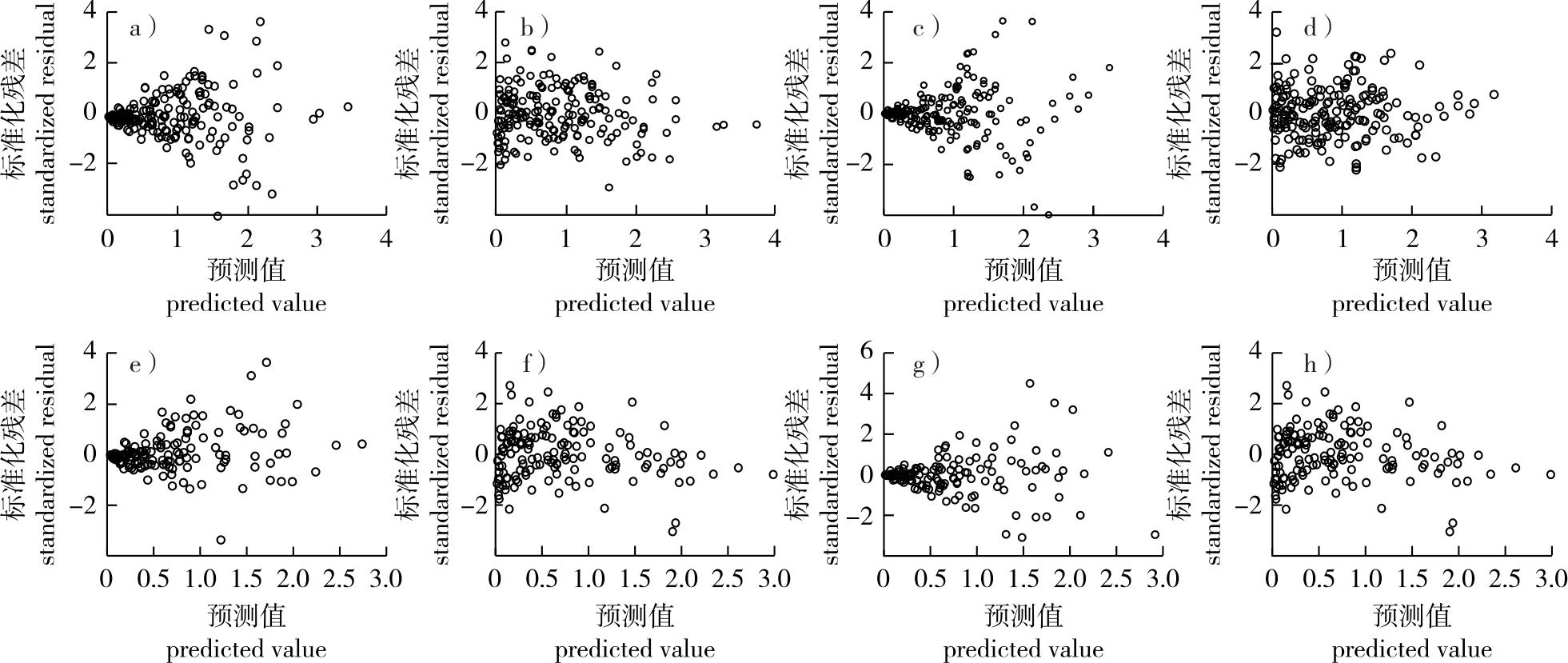 PDF(1638 KB)
PDF(1638 KB)


Effects of different form quotients on prediction accuracy of individual tree volume of Larix gmelinii
ZHANG Yijun, ZHANG Zipeng, JIANG Lichun
Journal of Nanjing Forestry University (Natural Sciences Edition) ›› 2025, Vol. 49 ›› Issue (3) : 95-102.
 PDF(1638 KB)
PDF(1638 KB)
 PDF(1638 KB)
PDF(1638 KB)
Effects of different form quotients on prediction accuracy of individual tree volume of Larix gmelinii
【Objective】This study took the Larix gmelinii in the Greater Khingan Mountains as the research subject. Based on breast height form quotient, normal form quotient, and ground form quotient, individual tree volume models incorporating different form factors were constructed. These models were then compared and analyzed against traditional one-variable and two-variable volume models, as well as the two-variable volume model for L. gmelinii in Northeast China.【Method】Based on the measured data of L. gmelinii, a series of breast height form quotients, normal form quotients, and ground form quotients at different heights of the trunk were introduced into the traditional volume model. One-variable and two-variable tree volume models with different form quotients were constructed, respectively, and variance functions were introduced to eliminate the heteroscedasticity in the fitting process of each volume model. The mean absolute error (MAE), root mean square error (RMSE), relative root mean square error (RMSE%), determination coefficient (R2), and Akaike information criterion (AIC) were used as evaluation indexes to fit and analyze each model.【Result】(1) The two-variable and three-variable models constructed with the introduction of the breast height form quotient at 50% relative tree height fitted best, with the three-variable tree volume model reducing the RMSE by 44.4% compared to the two-variable tree volume equation. (2) The three-variable volume model constructed by introducing the normal form quotient,at 50% of the relative tree height performed the best, reducing the RMSE by 23.1% compared to the two-variable volume model that incorporated the ground form quotient. (3) For the ground form quotient, the three-variable volume model achieved the best fit when the variable was set at 60% of the relative tree height, while the binary volume model performed optimally when the variable was set at 50% of the relative tree height. The three-variable volume model incorporating the ground form quotient reduced the RMSE by 32.5% compared to the two-variable volume model. (4) Compared to the two-variable volume equation for Larix gmelinii used in Northeast China, the three-variable volume model incorporating the breast height form quotient reduced the RMSE, MAE, and RMSE% by 62.85%, 65.02%, and 67.14%, respectively. The three-variable volume model containing the breast height form quotient reduced the RMSE by 60.41% compared to the traditional two-variable tree volume equations.【Conclusion】The form quotient is an important index of stem form, and the introduction of breast height form quotient, normal form quotient, and ground form quotient into the traditional volume models can improve the accuracy of predicting tree volume. The three-variable tree volume model has the best prediction effect with the introduction of the breast height form quotient. Therefore, it is recommended to use this model to predict the tree stem volume of L. gmelinii in the region in the future.

Larix gmelinii / breast height form quotient / normal form quotient / ground form quotient / individual tree volume
| [1] |
|
| [2] |
|
| [3] |
曾伟生, 贺东北, 蒲莹, 等. 含地域和起源因子的马尾松立木生物量与材积方程系统[J]. 林业科学, 2019, 55(2):75-86.
|
| [4] |
|
| [5] |
|
| [6] |
|
| [7] |
|
| [8] |
|
| [9] |
李悦黎, 杜纪山. 正形率系列特性及其应用的研究[J]. 西北林学院学报, 1994, 9(3):53-58.
|
| [10] |
|
| [11] |
|
| [12] |
种雨丝, 何培, 张兹鹏, 等. 应用地基激光雷达三维点云数据构建长白落叶松树干削度方程[J]. 东北林业大学学报, 2024, 52(3):69-75.
|
| [13] |
花伟成, 田佳榕, 孙心雨, 等. 基于TLS数据的杨树削度方程建立及材积估算[J]. 南京林业大学学报(自然科学版), 2021, 45(4):41-48.
|
| [14] |
高谢雨, 董利虎, 郝元朔. 基于TLS的抚育间伐对长白落叶松干形的影响[J]. 南京林业大学学报(自然科学版), 2023, 47(6):85-94.
|
| [15] |
|
| [16] |
中华人民共和国农林部. 立木材积表:LY 208—77[M]. 北京: 技术标准出版社,1978.
Agriculture and Forestry Ministry of China. Tree volume tables: LY 208—77[M]. Beijing: Technical Standards Press, 1978.
|
| [17] |
李凤日. 测树学[M]. 4版. 北京: 中国林业出版社,2019:1-397.
|
| [18] |
|
| [19] |
|
| [20] |
|
| [21] |
曾伟生. 我国主要树种二元立木材积表的检验[J]. 林业资源管理, 2018(5):35-41.
|
| [22] |
曾伟生, 杨学云. 我国一元立木材积表基本现状分析与估计误差检验[J]. 林业资源管理, 2023(2):43-49.
|
| [23] |
|
| [24] |
|
| [25] |
|
| [26] |
|
| [27] |
张兹鹏, 王君杰, 刘索名, 等. 形率对白桦单木材积和生物量预测精度的影响[J]. 林业科学, 2022, 58(5):31-39.
|
| [28] |
|
| [29] |
|
| [30] |
靳晓东, 姜立春. 基于树干不同形率的樟子松立木材积方程研建[J]. 北京林业大学学报, 2020, 42(3):78-86.
|
/
| 〈 |
|
〉 |